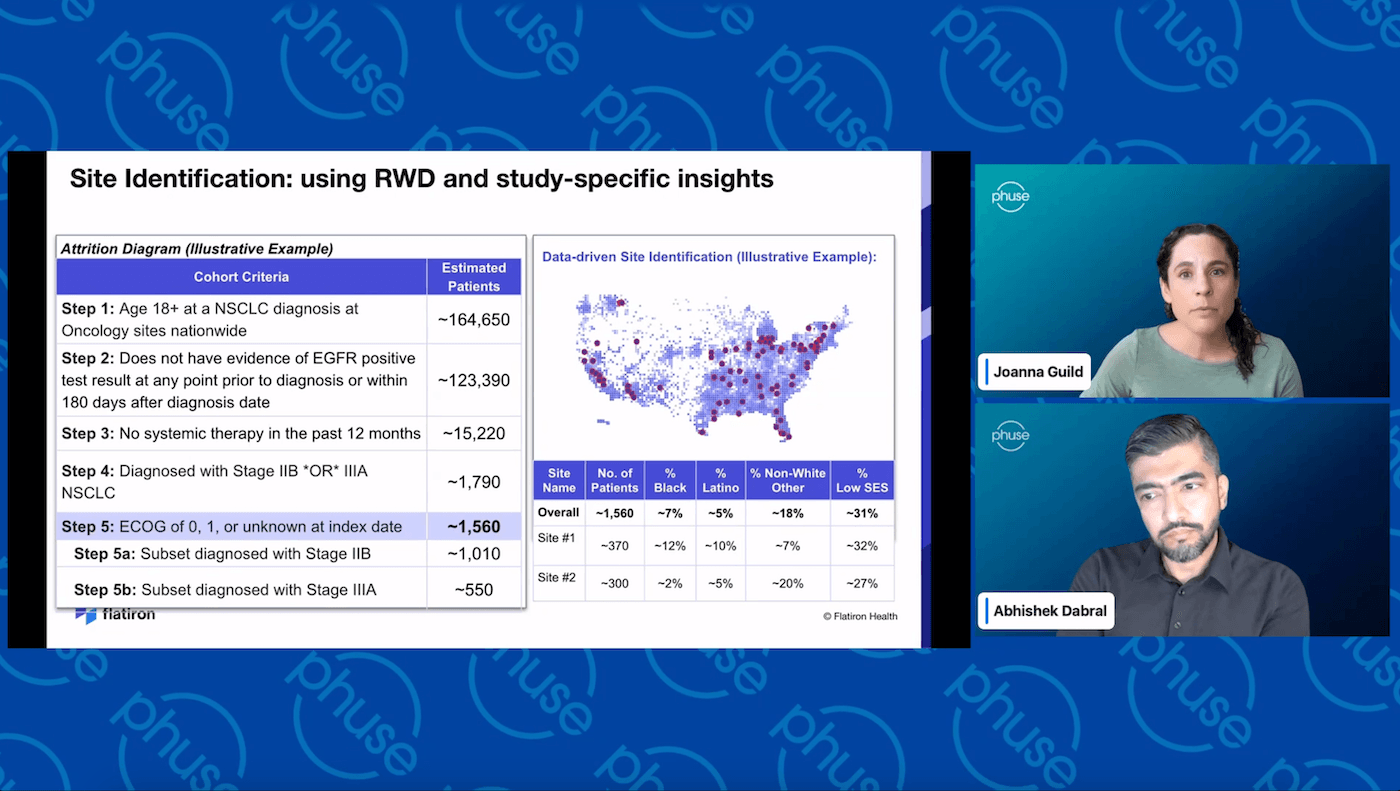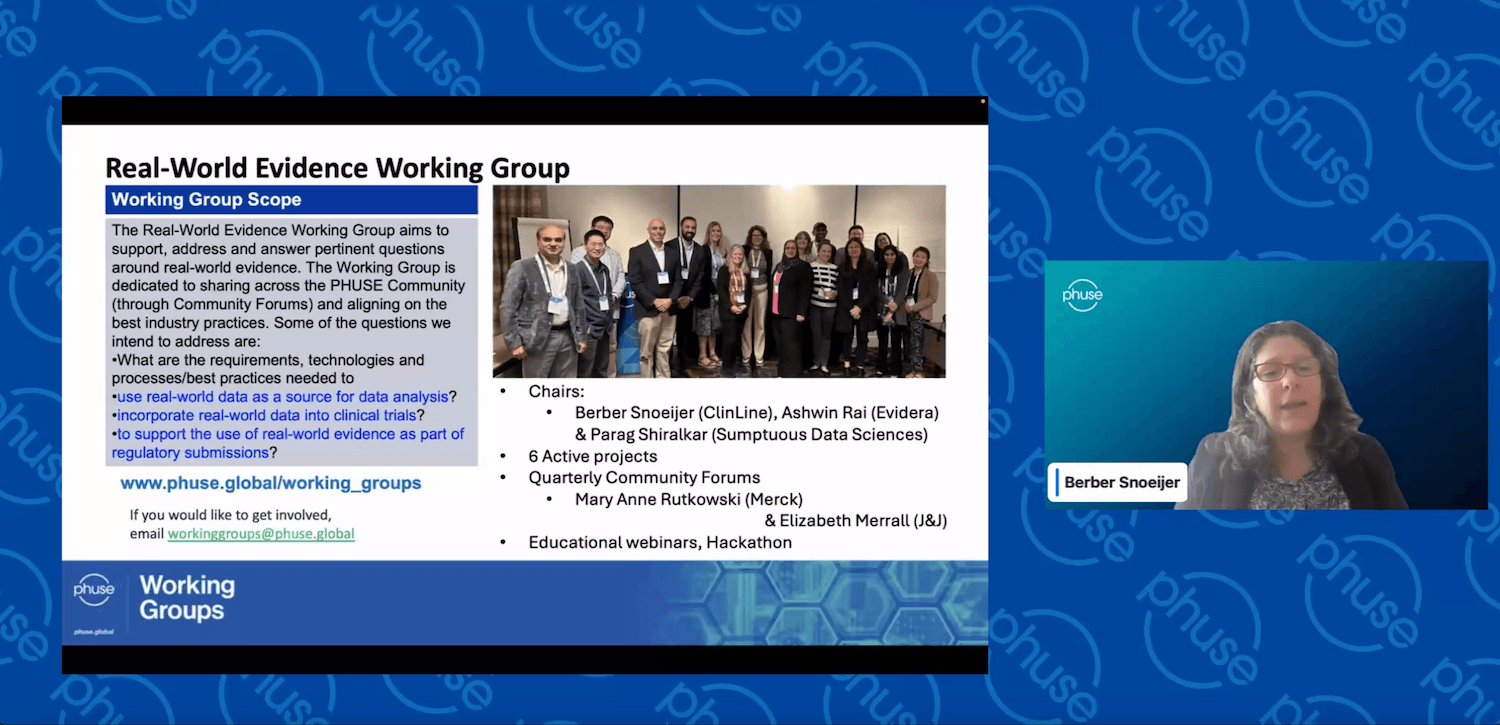The inaugural Real World Data Spring Event exceeded all expectations, bringing together 291 attendees from 25 countries and 118 companies to explore the evolving role of real world data in clinical research.
The event was created to harness and promote the developments that we’ve seen in various PHUSE Working Group projects, Community Forums and CSS breakout sessions. To allow as much participation as possible, the virtual event was spread over two days, with afternoon talks on the 9th and 10th of April from 14:00-16:30 (BST).
Day 1’s presentations focused on use cases of real world data utilisation, covering topics such as AI’s impact on healthcare statistics. Day 2 was centred around standardisation, compliance and data reliability in the space.
A huge thank you to our nine speakers for sharing their expertise and to everyone who joined us! All recordings and presentation slides are available on the PHUSE Advance Hub.
Continue reading for reflections of each day…
Day 1
Day 1 of the PHUSE Real World Data Spring Event 2025 offered a rich exploration of how the use of real-world data (RWD) in healthcare and clinical research is evolving. Speakers shared practical applications and thought-provoking insights into how data is harnessed to drive better outcomes, enhance safety monitoring and streamline clinical trial processes.
The theme of the day was RWD Utilisation: Use Cases and began with a presentation by Aracelis Torres, PhD, MPH of Verana Health, who explored how artificial intelligence is transforming unstructured healthcare data into actionable insights. With over 80% of healthcare data stored in unstructured formats such as clinician notes and EHR entries, AI techniques such as natural language processing and machine learning are proving invaluable. Aracelis demonstrated how these tools can derive clinically meaningful information at scale, supported by real-world examples in prostate and bladder cancer. She stressed the importance of clinician involvement throughout model development to ensure accurate and clinically valid outputs.
This was followed by a session from Dr Harini Vadlamudi of GSK, who focused on the role of RWD in safety assessments throughout the drug development life cycle. Drawing from a detailed use case, Dr Vadlamudi illustrated how claims data can be used to calculate incidence rates and identify potential safety signals. Her presentation highlighted how real-world evidence increasingly supports post-market surveillance, offering a faster and often more cost-effective way to monitor patient safety. She also discussed the need for robust data governance to address the challenges of quality, standardisation and privacy.
The third presentation of the day, by Ashley Pitcher, DPhil of IQVIA, introduced the patient-mediated approach to real-world data collection. Ashley discussed how this model empowers patients to directly contribute their health data for research, helping fill information gaps that traditional secondary data sources often miss such as symptom onset, lifestyle factors and quality of life. The session explored how digital tools, policy shifts such as GDPR, and national initiatives such as the European Health Data Space are facilitating this shift towards more patient-centric data models. The Our Future Health project in the UK was highlighted as a prime example of public engagement and willingness to participate in research via secure data sharing.
The day concluded with a dynamic presentation by Joanna Guild and Abhishek Dabral from Flatiron Health, who examined how RWD can be leveraged to enhance clinical trial recruitment and execution. They demonstrated how retrospective and real-time data are used to inform trial design, select diverse and appropriate study sites, and identify eligible patients more quickly. The integration of EHR systems with electronic data capture platforms was shown to significantly reduce manual data entry, improve data accuracy, and lessen the operational burden on trial sites. Their oncology-focused case study exemplified how protocol criteria can be optimised to enhance feasibility and inclusivity without compromising scientific rigour.
To wrap up the day, a panel discussion brought together all speakers for an insightful conversation. The panel reflected on the key themes of the day – AI-driven analytics, patient empowerment, regulatory evolution, and operational efficiency – offering attendees a broader perspective on how collaboration across disciplines is advancing the real-world data ecosystem.

Day 2
Day 2 continued to delve into the challenges and opportunities surrounding the use of real-world data (RWD) in regulatory and scientific contexts. The sessions focused on the theme of Standardisation, Compliance and Data Reliability.
The day opened with a technically rich session led by Alistair Dootson of EQTY Lab, who explored the application of cryptography and digital signatures to verify the quality and reliability of real-world data. Alistair presented a modular compliance framework built around four key elements – control, attestation, automation and lineage – establishing immutable, verifiable data provenance and governance records. He demonstrated how these cryptographic methods allow for real-time compliance monitoring, ensure auditability down to the datapoint level, and help organisations build trusted, interoperable data systems. Through a series of case studies, Alistair illustrated how this approach can streamline regulated workflows, enhance process transparency, and significantly reduce risk across complex data environments.
Tasha Nagamine and Anita Umesh (Droice Labs and Genentech/Roche, respectively) introduced the Clinical Data Interchange Standards Consortium (CDISC) RWD Lineage Initiative, a new standard aimed at enabling traceability from source data to analysis-ready datasets in submissions to regulatory authorities. In response to growing expectations from bodies such as the FDA, this initiative seeks to address current gaps in data transparency by implementing atomic lineage – a mechanism to trace each SDTM variable directly back to its source in the original real-world dataset. The presentation discussed common issues such as information loss and ambiguous mappings in RWD-derived SDTM files and how this new standard intends to resolve them. With applications across external control arms, pragmatic trials and natural history studies, the initiative is positioned to be a key enabler of trust in RWD for regulatory decision-making.
The afternoon featured a thought-provoking presentation from Takeda’s Dr Tamas Soroncz-Szabo, who addressed the growing use of RWD in treatment comparisons and the urgent need for standardisation and regulation in this space. He distinguished between traditional randomised controlled trials (RCTs), adjusted indirect comparisons (AICs) and real-world data-based approaches, discussing their relative strengths and limitations. While RWD offers invaluable insights from routine clinical practice, Dr Soroncz-Szabo cautioned that its evidentiary value is only as strong as its ability to minimise bias and confounding. He presented a comprehensive overview of emerging European and international guidelines – including EMA reflection papers and ICH initiatives – designed to strengthen the methodological integrity of RWD studies. The session concluded with a call to action for greater harmonisation across frameworks, more robust analytical validation, and the strategic use of AI to help navigate the inherent ‘noise’ within real-world datasets.
As the day drew to a close, a clear theme emerged: ensuring RWD is fit for purpose in regulatory and clinical contexts requires technological innovation, harmonised standards and rigorous methodology. Many thanks to the speakers for making this event such a thoughtful and engaging success!
